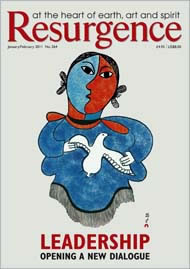Quite a number of us who are no longer young or even middle-aged enjoy talking together about what it is like to be as we are. We are comforted, I think, by knowing that someone else shares our infirmity or rather the ways in which our bodies age whilst we seem to remain as we have always been: angry, cheerful, scatty, competent, friendly, reclusive, and so on. My body is 68, but I am 27.
But whether or not we enjoy such talk, it is evident that ‘True Being’ means participating in the cycle of ageing. Everything we see follows the pattern of which the Buddha spoke when he arose from his deep meditation beneath the Bodhi tree: “Coming to be, coming to be; ceasing to be, ceasing to be.” The cycle of birth, life, death and renewal is all around us for those who have eyes to see and ears to hear. And, despite the obvious difficulties and discomforts of old age, its anxiety and distress come not from accepting the way things are but from denial, from seeking to be what we are not – forever young and in full bloom!
There is great peace to be found in such surrender.
John Lane’s Art of Ageing is therefore for those of us who are old and those of you who are moving towards us who are old. His book is amusing, honest, informative and full of good things.
Anyone who knows John personally will hear his voice in the text – gentle, wry, sometimes poking fun and pricking the bubble of pomposity, including his own! It is as if we are in conversation with him, sometimes nodding as he shows us something we, too, have already found; and sometimes being surprised by something else quite new to us. It is like walking arm-in-arm with an old friend and saying, “Yes, that’s how I feel, too,” and then, “Are you sure? I had never thought about it like that.”
For me, one of the ‘surprises’ was the idea that an increasingly aged population might alter or shift the underlying ethos of society – a gentle if somewhat grumpy revolution. I suppose it is obvious when you think about it, but I had not thought about it at all. Quoting Theodore Roszak’s “survival of the gentlest”, John suggests that as the old become a larger part of our society, the values that they profess may become more dominant:
“The increasing proportion of old people will in time tip the balance in favour of values that they hold dearest: the alleviation of suffering, non-violence, justice, nurturing, and the maintenance of the health and beauty of the planet [plus] the value of sacramental or holy living.”
This is quite a radical thought.
There is another good thing to which John draws our attention – the observation of small things and events: “look for the honest, the beautiful and the good”, he says. Gloomily drawing his bedroom curtains, he is startled by the sunshine of the early morning; his spirit is at once lifted by sunlight on a patch of earth. Time taken for such moments may be part of the privilege of old age – “the mystery that sings in all things and can only be experienced with a heart open to the new”.
And then, almost as an epilogue, John gives us a number of small ‘pictures’ of older people he has met. Largely written in their own words, these short glimpses into other people’s lives are rich and unexpected.
There is no sentimentality here. The pain and discomfort are real and tiresome. And there is often no ‘answer’ to what may happen next. But there is something else: moments of peacefulness and even equanimity quite beyond the reach of the young and anxious middle-aged. Insight? Well, maybe. Serenity? By chance, sometimes. But life being lived? Certainly. Until it isn’t. Well, not as we know it.
John does not offer us a treatise – and the book is all the better for this – but he does give us a series of pensées upon ageing, urging acceptance, preparation, and a delight in the detail. Lots of good stuff!
David Cadman’s book Holiness in the Everyday was published by Quaker Books in 2009, and ZIG Publishing will be publishing his latest book, A Way of Being in 2011. www.zigpublishing.com






